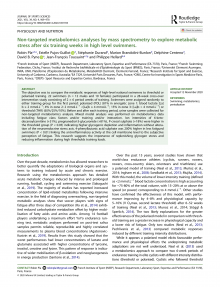-
PLA et Al 2021 PDF-2.22 MB
JOURNAL OF SPORTS SCIENCES
Robin Pla, Estelle Pujos-Guillot, Stéphanie Durand, Marion Brandolini-Bunlon, Delphine Centeno, David B. Pyne, Jean-François Toussaint & Philippe Hellard
ABSTRACT : The objective was to compare the metabolic responses of high-level national swimmers to threshold or polarised training. 22 swimmers (n = 12 males and 10 females) participated in a 28-week cross-over intervention study consisting of 2 × 6 period weeks of training. Swimmers were assigned randomly to either training group for the first period: polarised (POL) (81% in energetic zone 1: blood lactate [La] b ≤ 2 mmol.L−1; 4% in zone 2: 2 mmol.L−1 <[La]b ≤ 4 mmol.L−1; 15% in zone 3: [La]b > 4 mmol.L−1) or threshold (THR) (65%/25%/10%). Before and after each training period, urine samples were collected for non-targeted metabolomics analysis. Mixed model analysis was performed on metabolomics data including fatigue class factors and/or training and/or interaction. Ion intensities of 6-ketodecanoylcarnitine (+31%), pregnanediol-3-glucuronide (+81%), P-cresol sulphate (+18%) were higher in the threshold group (P < 0.05) indicating higher glycogenic depletion and inflammation without alteration of the neuroendocrine stress axis. 4-phenylbutanic acid sulphate was 200% higher in less fatigued swimmers (P < 0.01) linking the anti-inflammatory activity at the cell membrane level to the subjective perception of fatigue. This research suggests the importance of replenishing glycogen stores and reducing inflammation during high thresholds training loads.
